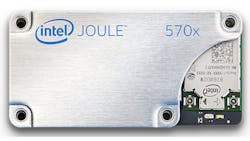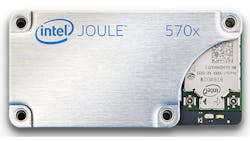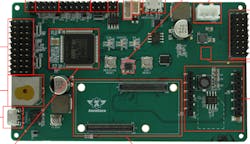It came near the end of Intel’s CEO’s keynote speech at the Intel Developers Forum, but the Intel Joule (Fig. 1) module looks to be a winner. It is designed for high-volume production and is essentially a PC on a module.
The Joule module (Fig. 2) is based on a 1.7-GHz, quad-core T5700 Atom with a 2.4-GHz burst mode. The Intel HD Graphics can drive 4K displays. The module has 4 Gbytes of LPDDR4 RAM and 16 Gbytes of eMMC flash storage. Wireless support includes 802.11ac Wi-Fi with MIMO and Bluetooth 4.1.
The module is designed for production, not just prototyping. It has four mounting holes and a pair of connectors on the back (Fig. 3). The connectors expose the video interface along with USB 3.0 and MPI CSI and DSI interfaces, along with multiple GPIO, I2C, and UART interfaces.
Small modules like the Joule have been available, and there are quite a few that are based on ARM processors. The big difference is that it is x86 and available directly from Intel. The design is solid and the functionality is on par with a laptop from a few years ago, but able to drive the latest 4K displays. It supports software that is optimized for Intel’s 3D RealSense camera.
I remember seeing a number of robot platforms like the iRobot Create running around carrying a small laptop that was the controller. The Joule module does everything that laptop would do while using a lot less power. Raspberry Pis handle this chore nowadays, but the Joule is more powerful and more compact.
The Joule kit (Fig. 4) available from Intel includes a Joule and Tuchuck carrier board. The module comes with Ostro Linux and will run a variety of operating systems, including Ubuntu Core (more about Ubuntu Core in the near future). It could have a significant impact on Joule, especially when it comes to software modularity and security.
The latest RealSense technology was also highlighted at IDF and part of the kit. Intel’s Diana Shea wore a set of safety glasses (Fig. 5) with a Joule and RealSense camera built in. This was not an augmented reality application, per se. Instead, the output of the RealSense camera is analyzed by the Joule based what the user sees. It identifies items in the field of view and determines if the process the user is performing is correct, audibly warning the user if an error occurs. The example was placing bolts into an airplane door that might be done during the construction process.
The scenario addressed the possibility that the video could be sent wirelessly to an offsite expert who could then see what was going on. They could converse with the user, as well. The augmented reality would be from the remote user’s perspective. This significantly reduces the complexity and weight from the user’s point of view while providing an overall benefit.
The cables shown in the image were to provide video output to IDF attendees. The unit would normally operate wirelessly without the cables using on-board batteries.
The Joule does not operate by itself. It needs a carrier board, and one is available in the kit. The Joule is supported by Gumstix Geppetto. I think this is very significant because the web-based design tool is easy to operate using a drag-and-drop interface. It handles all wiring transparent to the user, and the result is a fully populated board.
The cost encompasses a per-board charge and a $1,999 start-up fee. That is a fraction of what it would cost to do it in-house or through a contract design house. Gumstix has already used the tool to generate half-a-dozen designs like the AeroCore 2 (Fig. 6) that are available for only a per-board charge. That is pretty impressive given Gumstix turned this around in about a month, including integrating and testing the Joule support within the tool itself. The AeroCore 2 actually has an ARM Cortex-M4 on it to provide real-time control capabilities to the Joule. There are other modules that would be ideal for applications like digital signage.
I am looking forward to getting my hands on the Joule and the RealSense camera. That mix alone makes it interesting. The compact size, rugged design, and support from Intel make it an excellent platform for product systems that currently use boards or other modules. It is not for all applications, and some may think it too large for wearable applications, but it will all depend upon what the application is. The Joule is not a competitor to Intel’s Curie or other very compact ARM platforms designed for a smartwatch, but that is only a fraction of the wearable applications out there. There are even more applications where small size and video input and output will be important.
About the Author
William G. Wong
Senior Content Director - Electronic Design and Microwaves & RF
I am Editor of Electronic Design focusing on embedded, software, and systems. As Senior Content Director, I also manage Microwaves & RF and I work with a great team of editors to provide engineers, programmers, developers and technical managers with interesting and useful articles and videos on a regular basis. Check out our free newsletters to see the latest content.
You can send press releases for new products for possible coverage on the website. I am also interested in receiving contributed articles for publishing on our website. Use our template and send to me along with a signed release form.
Check out my blog, AltEmbedded on Electronic Design, as well as his latest articles on this site that are listed below.
You can visit my social media via these links:
- AltEmbedded on Electronic Design
- Bill Wong on Facebook
- @AltEmbedded on Twitter
- Bill Wong on LinkedIn
I earned a Bachelor of Electrical Engineering at the Georgia Institute of Technology and a Masters in Computer Science from Rutgers University. I still do a bit of programming using everything from C and C++ to Rust and Ada/SPARK. I do a bit of PHP programming for Drupal websites. I have posted a few Drupal modules.
I still get a hand on software and electronic hardware. Some of this can be found on our Kit Close-Up video series. You can also see me on many of our TechXchange Talk videos. I am interested in a range of projects from robotics to artificial intelligence.








